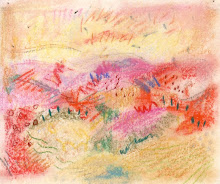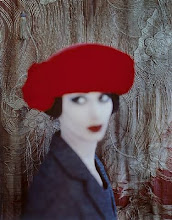Wednesday, 28 July 2010
The Senegalese Woman
July 2010
12.5cm x 15cm
Mixed water-based media (Windsor & Newton indian ink, Daler Rowney acrylic ink, Caran D'ache Neocolour II, Windsor & Newton gouache, Albrecht Durer watercolour crayon) on paper (100% cotton rag, acid-free).
The ubiquitous female face is my principle muse. Self-aware, she often looks directly out, appropriating the gaze to create equivalence and challenge the distinctions between the viewer and the viewed.
Saturday, 24 July 2010
Black Madonna
(Above) Black Madonna
A small painting in mixed media (indian ink, acrylic ink, Albrecht Durer watercolour crayons, Caran d'Ache Neocolour II) on paper.
12cm x 14cm
"Images of the Madonna with a black skin are seen throughout the world and are thought to originate in Africa. In France there are many examples, some of which may date from the Crusades. One theory is that the Knights Templars brought the black Madonna to Europe.
It is understood that the white skinned Madonna came into common use during the Middle Ages when the Marian cult, who adored Mary, mother of Jesus, was recognised by the Catholic Church. The first centre of the Marian cult in Britain was at Glastonbury, Somerset.
In some parts of the world the black Madonna is linked to Isis, an Ancient Egyptian goddess."
Quote from the Harry and Margery Boswell Art Collection website :
http://www.st-andrews.ac.uk/~muscoll/boswell/artworks/furneaux.htm
Tuesday, 20 July 2010
The Boy from Louisiana (carried the moon in his eyes)
(Above) The Boy from Louisiana (carried the moon in his eyes)
A mixed media painting (indian ink, watercolour crayon, poster paint) on paper.
12.5cm x 15cm
July 2010
This painting started as a study after a thumbnail photograph that I happened to find on the Internet of a black boy wearing a check jumper. To me, the boy looked as if he was from Mississippi. In a conversation with Sarah Howgate*, the New York portrait painter Alex Katz talks about how people from different countries, different cities, have a very distinctive and recognisable style or look. To me, the boy in this thumbnail had to be from one of the southern American states. So, he became “The Boy from Louisiana” and then with the blue ground in the painting suggesting a mythical midnight sky, his eyes seemed to echo, or carry, the moon, hence the final title. Titles are indeed great fun. They are not at all necessary but they do provide an opportunity to tell a story (often about how the painting came into being), to offer meanings, and using a periphrasis like this adds a poetry that is evocative of folk tales.
*In conversation with Alex Katz by Sarah Howgate, in Alex Katz Portraits, published the National Portrait Gallery Publications, St Martin’s Place, London, on the occasion of Alex Katz Portraits exhibition at the National Portrait Gallery, London, May - Sept, 2010.
Sunday, 18 July 2010
The Arab Boy on Page 861
(Above) The Arab Boy on Page 861
13cm x 15.5cm
July 2010
mixed media on paper
I've developed this painting from a Sony Reader drawing/study that I've done of a portrait that I happened to see by chance whilst browsing through a book called 1001 Paintings You Must See Before You Die. Professor Stephen Farthing has included in his selection a Portrait of a Youth by the Iranian artist Mohammad Reza Irani (page 861).
Saturday, 17 July 2010
Black Madonna
(Above) Black Madonna
July 2010
A small painting (12.5cm x 15cm) developed from one of my Sony Reader drawings of the same title.
"Images of the Madonna with a black skin are seen throughout the world and are thought to originate in Africa. In France there are many examples, some of which may date from the Crusades. One theory is that the Knights Templars brought the black Madonna to Europe.
It is understood that the white skinned Madonna came into common use during the Middle Ages when the Marian cult, who adored Mary, mother of Jesus, was recognised by the Catholic Church. The first centre of the Marian cult in Britain was at Glastonbury, Somerset.
In some parts of the world the black Madonna is linked to Isis, an Ancient Egyptian goddess."
The Harry and Margery Boswell Art Collection
Webpage :
http://www.st-andrews.ac.uk/~muscoll/boswell/artworks/furneaux.htm
Go to this site to find out more about the Scottish artist Paul Furneaux who produced this print :
Thursday, 15 July 2010
The Polynesian
(Above) The Polynesian
A mixed media painting on paper.
12cm x 14cm
July 2010
I developed this painting from one of my Sony Reader drawings ; a drawing which, like the painting, refers to Gauguin, in particular Girl with a Fan (see the post from 14 July 2010, a bit further below)
Wednesday, 14 July 2010
Sunday, 11 July 2010
Naked save Mr van Dongen's big black hat: SOLD!
(Above) Naked save Mr van Dongen's big black hat
July 2010
12cm x 14cm
Kees van Dongen is one of my favourite artists. He was very good at painting women, probably because, by his own admission, he painted them smaller and their jewellery bigger. And Max Factor would die for his masterful application of mascara, so to speak. This painting was inspired by a van Dongen portrait of a lady in a black hat.
Thursday, 8 July 2010
The Viennese Mermaid
(Above) The Viennese Mermaid
Mixed media on acrylic paper (i.e. indian ink, acrlyic ink, gouache, Caran d'ache Neocolour II, Derwent watercolour crayons)
13cm x 15.5cm
July 2010
I developed this painting from a study that I produced using the Handwriting App of the Sony Reader of Adam and Eve by Gustave Klimt.
Wednesday, 7 July 2010
Naked in Mr Vermeer's Splendid Red Hat: SOLD!
Mixed media on paper: indian and acrylic ink, gouache, watercolour crayons, Caran d'Ache Neocolour II crayons, poster paints.
12cm x 15 cm
July 2010
Tuesday, 6 July 2010
In praise of the sun
Sunna
A mixed media (indian ink, acrylic ink, gouache, poster paint, watercolour) on paper (10cm x 14cm).
July 2010
Sunna is a sun goddess. We often think of the sun deity as being male, because of the legacy of Greek and Roman mythologies. However, in many mythologies the sun is worshiped as a goddess. In old high German mythology the sun is personified as Sunna.
Monday, 5 July 2010
She posed naked for Monsieur Bonnard
She posed naked for Monsieur Bonnard
July 2010
A small (9.5cm x 11. 5cm) mixed media (indian ink, acrylic ink, gouache and a teeny weeny bit of watercolour) painting developed from a Sony Reader drawing/study (below) prompted by a Bonnard painting.
Sunday, 4 July 2010
The Black Girl
The Black Girl
July 2010
Another small (7.5cm x 9cm), mixed media painting on paper, developed from one of my Sony Reader drawings.
Cover Girls
Saturday, 3 July 2010
Skinny girl in a pink t-shirt
A small (7.5cm x 9cm), mixed media painting on paper, developed from a Sony Reader drawing (now posted on the other blog "The doodle bug" - to see this blog, click on the image of "Les wearing his check jacket" in the left hand column).
July 2010.
My paintings are paintings that happen to be of people, mostly women. When I find a subject it is often because something about the image/sitter prompts me to think "this would make a good painting" rather than "I'd like to make a/do their portrait." Sometimes the resulting work shows a good likeness but not always simply because I am more concerned with the marks and colours and the relationships between them that make up a painting. So why so much focus on the female face when I could explore these "painting" issues through landscapes or still lives or non figurative work ? Because the face fascinates, because women tend to do more with their hair ("big" hair makes great shapes) and make-up and I like the strong graphic marks that mascara allows.
The National Portrait Gallery in London is currently showing a small exhibition of paintings by the American artist Alex Katz. The exhibition catalogue includes a transcript of a conversation where Katz talks to Sarah Howgate about portrait painting :
Sarah Howgate: "You've said that your concern is not with psychology but with the painted surface. Many artists attempt to get under the skin of their subject, but this is not what you're trying to do."
Alex Katz: "I've always thought that appearance is one of the most mysterious things. What is appearance today? There are no absolutes. It's a matter of sensation. Appearance, or reality, is a variable and it changes every twenty or thirty years."
(Above) The Green Cap (oil on board) by Alex Katz
Thursday, 1 July 2010
Subscribe to:
Comments (Atom)



.jpg)










.jpg)




































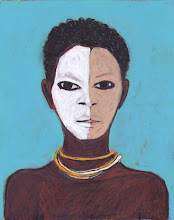
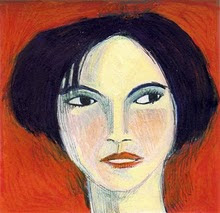
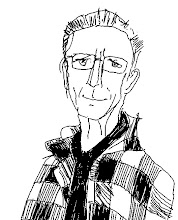



.jpg)








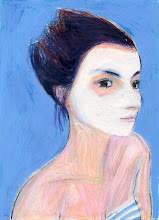








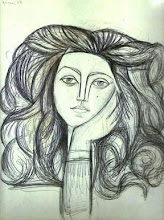

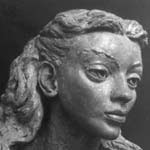




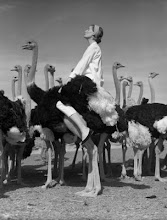
.jpg)

